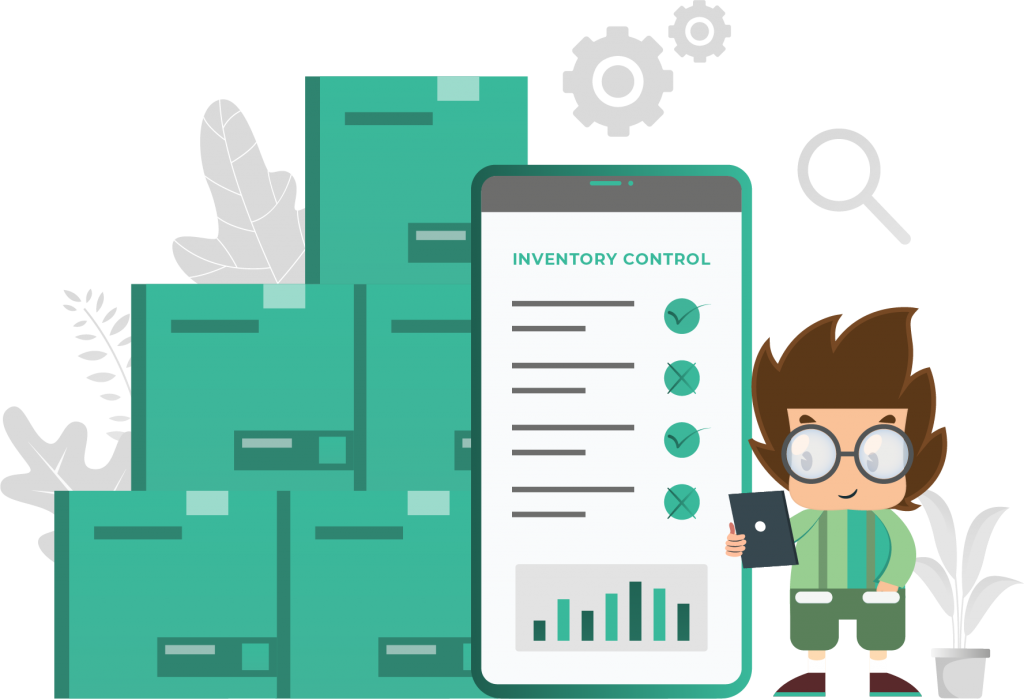Inventory Control Definitions and Methods
Inventory Management
LAST UPDATE: MAY 31, 2022
5 minutes reading
The term inventory is given to the goods or products that an establishment owns and may be sellable.This stock is one of the most important assets that the establishment owns. Therefore, companies must pay attention to control and manage it well.
You might ask “What is inventory control?!!” and “What is the difference between inventory control and inventory management?” or even “What is the importance of inventory control?”.
Let’s see the answers to all these questions.
Inventory Control Definition
Inventory control, also known as stock control, is the process that oversees warehouse management and the organization of its stock. It includes tracking, classifying, replenishing, and turnover of these products to maintain the ideal levels of inventory. This ensures that you meet customers’ orders in a timely manner.
The inventory control functional aspects include barcode control, management of inventory lists and counts, reorder reports, warehouse reports, product locations and details, synchronizing warehouse stock with sales orders and purchase orders, supply chain management, and accounting operations of warehouse management.
The importance of inventory control lies in the fact that it enables companies to make the right decisions to control stock levels and make the best use of the available resources.
Inventory Control Vs. Inventory Management
Inventory control and inventory management may seem similar, but stock control is generally a part of inventory management.
Managing inventory is done through the so-called inventory management system, which is defined as planning and organizing the processes of receiving and maintaining materials and supplies and supplying entities. Meanwhile, demanding their needs in a timely manner as companies incur costs of warehousing and inventory tracking.
However, poorly managed stocks can create major financial problems for businessmen, whether mismanagement leads to overstocking or shortage of inventory.
Successful inventory management includes creating a purchase plan to ensure materials are available when you need them to avoid exposure to the two biggest problems:
– Out of stocks lead to the stopping of production and the inability to keep pace with the movement of demand in the market.
– Overstocks, which means not investing the value of the excess stock, which may affect the validity of its use, in addition to utilizing storage space without interest.
Therefore, we always face the problem of determining the optimum stock value and the appropriate time to issue the supply order to suppliers, and the optimum quantity for each supply order.
So, What Is The Difference?
Inventory Control is the supervision of inventory and stock in your warehouses and all related operations, such as sales and purchase orders, storage handling, transportation costs, and avoiding product spoilage.
On the other hand, inventory management includes the activities of forecasting and demand planning and creating a purchase plans with its associated calculations, like re-order point calculations and replenishment of stock calculations.
In other words, inventory control is the arms and legs of your business while the inventory management is the brain which processes the data from the inventory control and turns it into good information that enables you to make right decisions for your business.
Inventory Control Methods
Proper inventory control saves the company a lot of costs and maximizes profits without affecting customer satisfaction.
Let’s talk about the methods that tell you what is in stock and when to order:
1-ABC Analysis:
This inventory categorization technique splits subjects into three categories based on value, cost, and consumption to identify items that have a heavy impact on overall inventory cost.
- First: category A serves as the high-value products that contribute the most to overall profit.
- Second: category B is the products that have moderate value and moderate sales frequency.
- Third: category C is for those with low value and high sales frequency that are vital for overall profit.
Check the link below for more information:
https://www.cleverism.com/complete-guide-abc-analysis-customer-segmentation-inventory/
2-Economic Order Quantity (EOQ):
This formula calculates the optimum amount of stock you need to make the costs of ordering and storing minimal:
EOQ = √(2SD/ H)
EOQ – economic order quantity (units)
S – ordering cost per purchase
D – demand in units
H – carrying cost per unit
For more information about this formula, click here.
3- Reorder Point Formula
The reorder point formula calculates the right time to order more stock.
It is the sum of your lead time demand and safety stock.
Reorder point formula = lead time + safety stock.
– The lead time demand is the lead time for a particular product multiplied by the average daily consumption of this product.
(Lead time is the number of days between placing order till it is delivered into your warehouse).
The efficient inventory management software will combine the economic order quantity with the reorder point.
Inventory Control Best Practices
-
Define Your Objectives
To determine your goal, you need to answer these questions:
What product types and quantities do you need in your inventory and what features do you need to manage your stock? Don’t forget to consider the cost of all your operations like transportation and storage expenses and your ROI calculation.
-
Have Your Work Organized
Maintain organizational control over your inventory and use inventory management techniques to perform stock counts and keep an eye on goods’ quantities. Don’t forget to control quality standards in your products as they form an important part of inventory control.
-
Use Inventory Management Systems
Owners of small and emerging businesses would be stunned to see how much help they can get and money they can save by wisely managing their inventory. Many small businesses are not rolling in cash, and much of their funding is tied up in their inventory. Good practices balance customer demand and management of inventory in the smartest possible ways.
– David Pyke, professor of operations and supply chain management at the University of San Diego
Some small or startup companies perform their inventory control operations using Excel spreadsheets, which are great for storing information but must be manually updated by a competent person. They must manually amend all goods and warehouse data continuously.
On the contrary, inventory control systems save time and costs by performing these functions in seconds as they track customer orders, oversee inventory levels, manage warehouse systems, barcodes, and product movement, perform sales analysis and forecast processes, and also organize backorders and overstocking.
Take a look at our inventory management software here.
New G Solution Inventory Management Software
New G Solution is a perfect inventory solution that puts you in the driver’s seat. It gives you full control over your inventory by its seamless integration with many solutions, managing your stock, and synchronizing all your warehouse processes.
As a result, New G Solution will make your customers happy, and allow you to maintain your relationships with suppliers.






Recent Comments